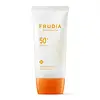What's inside
What's inside
 Key Ingredients
Key Ingredients

 Benefits
Benefits

 Concerns
Concerns

 Ingredients Side-by-side
Ingredients Side-by-side

Water
Skin ConditioningEthylhexyl Methoxycinnamate
UV AbsorberTitanium Dioxide
Cosmetic ColorantGlycerin
HumectantDipropylene Glycol
HumectantDibutyl Adipate
EmollientC12-15 Alkyl Benzoate
AntimicrobialDiethylamino Hydroxybenzoyl Hexyl Benzoate
UV FilterNiacinamide
SmoothingEthylhexyl Triazone
UV AbsorberGlyceryl Stearate
EmollientCetearyl Alcohol
EmollientCetyl Alcohol
EmollientPolysorbate 60
EmulsifyingDimethicone
EmollientPEG-100 Stearate
Aluminum Hydroxide
EmollientCetearyl Olivate
Glyceryl Caprylate
EmollientSorbitan Olivate
EmulsifyingPolyhydroxystearic Acid
EmulsifyingHydroxyethyl Acrylate/Sodium Acryloyldimethyl Taurate Copolymer
Emulsion StabilisingStearyl Alcohol
EmollientCetearyl Glucoside
EmulsifyingMethicone
EmollientTocopheryl Acetate
AntioxidantMyristyl Alcohol
EmollientAdenosine
Skin ConditioningLauryl Alcohol
EmollientSorbitan Isostearate
EmulsifyingPearl Powder
Citrus Unshiu Peel Extract
MaskingCoco-Caprylate/Caprate
EmollientButylene Glycol
HumectantGlucose
HumectantMacadamia Ternifolia Seed Oil
EmollientVitis Vinifera Seed Oil
EmollientPrunus Armeniaca Kernel Oil
MaskingPropylene Glycol
HumectantPEG-5 Rapeseed Sterol
CleansingCholesterol
EmollientBrassica Campestris Sterols
EmollientBiosaccharide Gum-4
Skin ConditioningMangifera Indica Fruit Extract
Skin ConditioningHydrogenated Lecithin
EmulsifyingGlutathione
Garcinia Mangostana Peel Extract
Skin ConditioningCeteth-5
EmulsifyingCeteth-3
EmulsifyingSolanum Lycopersicum Seed Oil
EmollientSodium Ascorbyl Phosphate
AntioxidantPunica Granatum Seed Oil
EmollientMangifera Indica Seed Oil
EmollientCitrus Paradisi Seed Oil
PerfumingCetyl Phosphate
EmulsifyingEthylhexylglycerin
Skin ConditioningMalpighia Emarginata Fruit Extract
Skin ConditioningTocopherol
AntioxidantPhenoxyethanol
Preservative1,2-Hexanediol
Skin ConditioningChlorphenesin
AntimicrobialDisodium EDTA
Parfum
MaskingCoumarin
PerfumingAlpha-Isomethyl Ionone
PerfumingCitronellol
PerfumingHydroxycitronellal
PerfumingWater, Ethylhexyl Methoxycinnamate, Titanium Dioxide, Glycerin, Dipropylene Glycol, Dibutyl Adipate, C12-15 Alkyl Benzoate, Diethylamino Hydroxybenzoyl Hexyl Benzoate, Niacinamide, Ethylhexyl Triazone, Glyceryl Stearate, Cetearyl Alcohol, Cetyl Alcohol, Polysorbate 60, Dimethicone, PEG-100 Stearate, Aluminum Hydroxide, Cetearyl Olivate, Glyceryl Caprylate, Sorbitan Olivate, Polyhydroxystearic Acid, Hydroxyethyl Acrylate/Sodium Acryloyldimethyl Taurate Copolymer, Stearyl Alcohol, Cetearyl Glucoside, Methicone, Tocopheryl Acetate, Myristyl Alcohol, Adenosine, Lauryl Alcohol, Sorbitan Isostearate, Pearl Powder, Citrus Unshiu Peel Extract, Coco-Caprylate/Caprate, Butylene Glycol, Glucose, Macadamia Ternifolia Seed Oil, Vitis Vinifera Seed Oil, Prunus Armeniaca Kernel Oil, Propylene Glycol, PEG-5 Rapeseed Sterol, Cholesterol, Brassica Campestris Sterols, Biosaccharide Gum-4, Mangifera Indica Fruit Extract, Hydrogenated Lecithin, Glutathione, Garcinia Mangostana Peel Extract, Ceteth-5, Ceteth-3, Solanum Lycopersicum Seed Oil, Sodium Ascorbyl Phosphate, Punica Granatum Seed Oil, Mangifera Indica Seed Oil, Citrus Paradisi Seed Oil, Cetyl Phosphate, Ethylhexylglycerin, Malpighia Emarginata Fruit Extract, Tocopherol, Phenoxyethanol, 1,2-Hexanediol, Chlorphenesin, Disodium EDTA, Parfum, Coumarin, Alpha-Isomethyl Ionone, Citronellol, Hydroxycitronellal
Water
Skin ConditioningSodium Hyaluronate
HumectantPentylene Glycol
Skin ConditioningPropanediol
SolventSodium Hyaluronate Crosspolymer
HumectantPanthenol
Skin ConditioningAhnfeltia Concinna Extract
Skin ConditioningGlycerin
HumectantTrisodium Ethylenediamine Disuccinate
Citric Acid
BufferingIsoceteth-20
EmulsifyingEthoxydiglycol
HumectantEthylhexylglycerin
Skin ConditioningHexylene Glycol
Emulsifying1,2-Hexanediol
Skin ConditioningPhenoxyethanol
PreservativeCaprylyl Glycol
EmollientWater, Sodium Hyaluronate, Pentylene Glycol, Propanediol, Sodium Hyaluronate Crosspolymer, Panthenol, Ahnfeltia Concinna Extract, Glycerin, Trisodium Ethylenediamine Disuccinate, Citric Acid, Isoceteth-20, Ethoxydiglycol, Ethylhexylglycerin, Hexylene Glycol, 1,2-Hexanediol, Phenoxyethanol, Caprylyl Glycol
 Reviews
Reviews

Alternatives
Ingredients Explained
These ingredients are found in both products.
Ingredients higher up in an ingredient list are typically present in a larger amount.
1,2-Hexanediol is a synthetic liquid and another multi-functional powerhouse.
It is a:
- Humectant, drawing moisture into the skin
- Emollient, helping to soften skin
- Solvent, dispersing and stabilizing formulas
- Preservative booster, enhancing the antimicrobial activity of other preservatives
Ethylhexylglycerin (we can't pronounce this either) is commonly used as a preservative and skin softener. It is derived from glyceryl.
You might see Ethylhexylglycerin often paired with other preservatives such as phenoxyethanol. Ethylhexylglycerin has been found to increase the effectiveness of these other preservatives.
Glycerin is already naturally found in your skin. It helps moisturize and protect your skin.
A study from 2016 found glycerin to be more effective as a humectant than AHAs and hyaluronic acid.
As a humectant, it helps the skin stay hydrated by pulling moisture to your skin. The low molecular weight of glycerin allows it to pull moisture into the deeper layers of your skin.
Hydrated skin improves your skin barrier; Your skin barrier helps protect against irritants and bacteria.
Glycerin has also been found to have antimicrobial and antiviral properties. Due to these properties, glycerin is often used in wound and burn treatments.
In cosmetics, glycerin is usually derived from plants such as soybean or palm. However, it can also be sourced from animals, such as tallow or animal fat.
This ingredient is organic, colorless, odorless, and non-toxic.
Glycerin is the name for this ingredient in American English. British English uses Glycerol/Glycerine.
Learn more about GlycerinPhenoxyethanol is a preservative that has germicide, antimicrobial, and aromatic properties. Studies show that phenoxyethanol can prevent microbial growth. By itself, it has a scent that is similar to that of a rose.
It's often used in formulations along with Caprylyl Glycol to preserve the shelf life of products.
Water. It's the most common cosmetic ingredient of all. You'll usually see it at the top of ingredient lists, meaning that it makes up the largest part of the product.
So why is it so popular? Water most often acts as a solvent - this means that it helps dissolve other ingredients into the formulation.
You'll also recognize water as that liquid we all need to stay alive. If you see this, drink a glass of water. Stay hydrated!
Learn more about Water